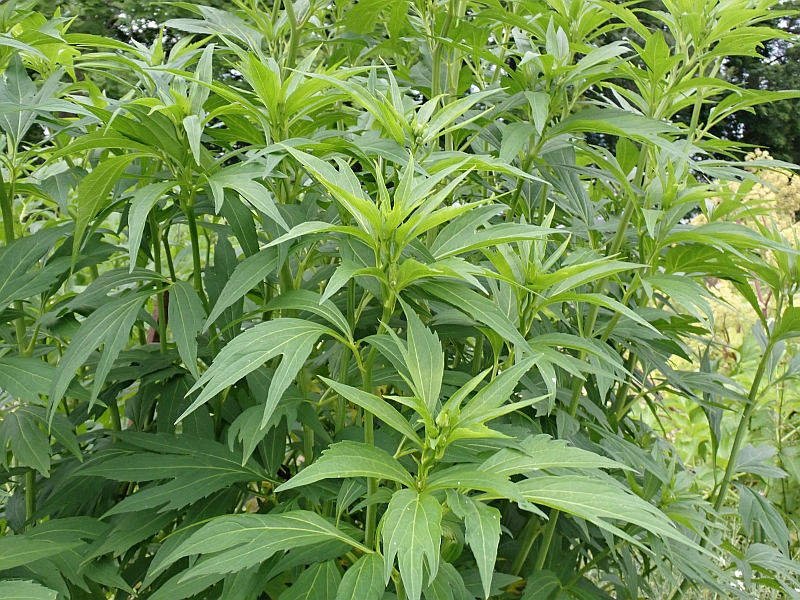When giving talks I like to renew myself and talk about something different each time. For my talk in Copenhagen at the Future Heirloom event last weekend I focussed during part of my presentation on edimentals in the Asteraceae or Compositae (the aster or daisy family / kurvplantefamilien). These are tbe edible perennial vegetables that are most obvious in the autumn garden and often underutilised by chefs in the west. Visiting the World Garden a few days before my talk on 17th October, I gathered flowers from all the flowering Asteraceae and here they are with names: Most are used for their tasty spring shoots and leaves, used cooked and raw, and most have a characteristic fragrant taste / aroma loved in the Far East (as also Chrysanthemum tea is popular and a refreshing accompaniment to spicy dishes). Aster scaber and Ligularia fischeri are nowadays both cultivated in a big way as “sannamul” in Korea and even exported to Korean markets around the world. Young shoots of other Aster sp. are foraged in Asia as is big-leaf Aster, Aster macrophyllus, in North America. Also from North America, cutleaf coneflower Rudbeckia laciniata or sochan was a popular vegetable for the Cherokee first people and in recent years has, maybe not unsurprisingly become a commercial vegetable in Korea. Annual shungiku or chopsuey greens Glebionis coronaria hails from the Mediterranean but is today an important vegetable in the Far East! Others currently in flower are best known as root crops, including (in the picture) Jerusalem artichoke (Helianthus tuberosus) and Dahlia. Yacon (Polymnia sonchifolia) is also autumn flowering but doesn’t manage to flower here (is moved indoors to flower and bulk up). The final flower in the picture is marigold Calendula officinalis, whose culinary use includes decorating and flavouring salads, soups and other dishes.
Most are used for their tasty spring shoots and leaves, used cooked and raw, and most have a characteristic fragrant taste / aroma loved in the Far East (as also Chrysanthemum tea is popular and a refreshing accompaniment to spicy dishes). Aster scaber and Ligularia fischeri are nowadays both cultivated in a big way as “sannamul” in Korea and even exported to Korean markets around the world. Young shoots of other Aster sp. are foraged in Asia as is big-leaf Aster, Aster macrophyllus, in North America. Also from North America, cutleaf coneflower Rudbeckia laciniata or sochan was a popular vegetable for the Cherokee first people and in recent years has, maybe not unsurprisingly become a commercial vegetable in Korea. Annual shungiku or chopsuey greens Glebionis coronaria hails from the Mediterranean but is today an important vegetable in the Far East! Others currently in flower are best known as root crops, including (in the picture) Jerusalem artichoke (Helianthus tuberosus) and Dahlia. Yacon (Polymnia sonchifolia) is also autumn flowering but doesn’t manage to flower here (is moved indoors to flower and bulk up). The final flower in the picture is marigold Calendula officinalis, whose culinary use includes decorating and flavouring salads, soups and other dishes.
Late flowering also means that the Asteraceae are also particularly important for a range of insect pollinators like hoverflies, drone flies and bees as can be seen in the pictures below, all taken in the World Garden:
Tag Archives: sochan
Sochan and Moly scrambled egg Meditteranean style
Lunch today was inspired by the Mediterranean diet – simple with masses of greens, but with an international twist: Cherokee spinach (top shoots of sochan – Rudbeckia laciniata / kyss-meg-over-gjerde), nettles (nesle), shallots (sjalott) harvested and stored since October, greater musk mallow (rosekattost) (Malva alcea), day lilies (dagliljer) flower buds, sand leek (bendelløk) (Allium scorodoprasum) and nodding onion / prærieløk (Allium cernuum) flowers. Added wild oregano (Origanum vulgare), dried orange milkcap / Granmatrisken (Lactarius deterrimus) and home grown chili salt a la “Are Sende Osen” (a gift during his visit this week), served with Allium moly flowers (from the mountains of Spain).




Garden foraged perennial veggies: 28th June 2023
Tonight’s perennial vegetables from the garden, used in a stir-fry:
Top right and clockwise:
Sochan / Cherokee greens tops (Rudbeckia laciniata); Norsk: Kyss-meg-
over-gjerde (picture at the bottom)
Sorrel (Rumex acetosa) “Skomvær”; Norsk: engsyre (picture at the bottom)
Garlic shoots (Allium sativum) from a clump grown as a perennial; Norsk: hvitløk
Perennial chicory tops (Cichorium intybus)
Urtica platyphylla (a Japanese nettle species; later than Urtica dioica)
Cabbage thistle (Cirsium oleraceum); Norsk: kåltistel From top and down
From top and down
Sherpa onion (Allium wallichii); perfect time for harvesting; Norsk: Sherpaløk
Hogweed tops (Heracleum); Norsk: bjørnekjeks
Hosta fortunei var. albopicta f. aurea
Allium nutans; Norsk: Sibirsk nikkeløk Sochan tops are excellent
Sochan tops are excellent A sorrel I collected at Skomvær, an island outermost in the Lofoten Islands; it is floriferous and has a compact growth form!
A sorrel I collected at Skomvær, an island outermost in the Lofoten Islands; it is floriferous and has a compact growth form!
Sochan tops Mediterranean style
Thanks to Alan Bergo (@foragerchef) for reminding me to try sochan tops. This is Rudbeckia laciniata (cut-leafed coneflower) which in the double form is one of the most popular garden ornamentals here in Norway over the last 100 years and a plant that has been commercialised as a farm vegetable over recent years in Korea. I’d previously only eaten the spring shoots, but I was equally impressed by the tops which I used simply cooked with onion, garlic and yellow zucchini from the garden, various fungi picked in the woods (saffron milkcap/matriske; hedgehog fungus / piggsopp and chantarelles / kantarell) and scrambled with eggs with a little chilim added (a classic way for preparing wild edibles in the Mediterranean countries. See the pictures below.
See other posts on this great vegetable which was introduced to me in one of Samuel Thayer’s books:
Appalachian Greens
Cherokee Pizza 




























